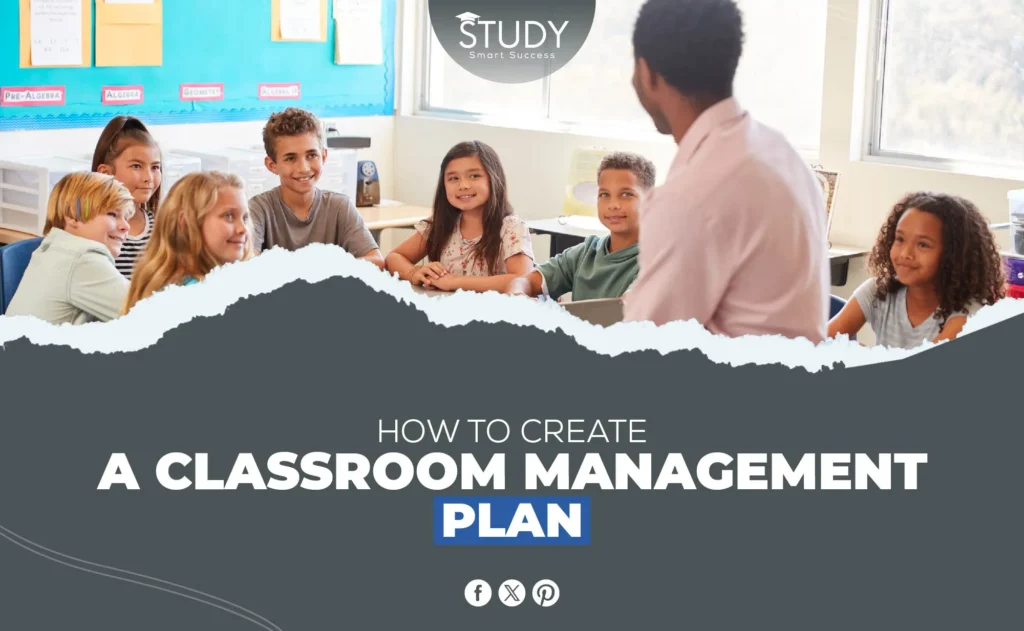Introduction
Effective classroom management is essential to foster a positive learning environment where instructors and students may flourish. A Classroom Management Plan is a road map for upholding discipline, encouraging good conduct, and maximizing class time. Let’s examine the key elements and procedures for creating an effective classroom management plan. Read further about understanding the Principles of Adult learning.
Components of a Classroom Management Plan
Establishing rules and expectations
A peaceful classroom environment must be established from the beginning by clearly defining expectations. Teachers help kids develop a feeling of ownership and responsibility by allowing them to participate in creating rules.
Consistency in enforcement
Reinforcing behavioral standards requires consistency. Teachers must apply the rules fairly and uniformly to ensure that the penalties for breaking the rules are consistently enforced.
Positive reinforcement strategies
Students may be effectively encouraged to maintain good conduct by using positive reinforcement to recognize and reward acceptable behavior. This might be verbal compliments, encouraging remarks, incentives, or advantages. Students may be inspired, and a pleasant learning environment can be sustained by implementing a system that rewards excellent conduct as it happens.
Proactive classroom management
By taking proactive measures, behavioral problems may be avoided before they start. This entails developing interesting class ideas, setting up a schedule that students can adhere to, and paying attention to their requirements. Teachers may prevent students from being distracted or getting into disagreements by proactively resolving possible distractions and confrontations.
Effective communication
A good classroom management plan depends on the instructor and students having clear and efficient communication. This covers how instructors listen to students’ worries and suggestions and communicate expectations and criticism. Maintaining open contact with kids promotes a courteous and upbeat classroom environment by making them feel heard and respected.
Building positive relationships
Building strong bonds with others is the first step toward efficient classroom management. Educators who develop close relationships with their pupils create an atmosphere favorable to learning and encourage a community of support among their peers.
Classroom environment
The classroom’s physical design and emotional atmosphere greatly influence how students behave and participate. A friendly, orderly classroom atmosphere encourages concentration and minimizes distractions.
Instructional strategies
Various teaching strategies cater to diverse learning requirements and preferences, which keep pupils motivated and involved. Teachers should use interactive teaching techniques and differentiation tools to improve student learning results.
Communication with stakeholders
Working with coworkers and parents/guardians improves the efficiency of classroom management initiatives. Open communication channels help create a support network that helps students succeed.
Steps to Develop a Classroom Management Plan
Assessing classroom needs
The first step in creating a customized management strategy is to comprehend the distinct traits and dynamics of the classroom community. Instructors need to recognize possible obstacles and opportunities for development.
Setting clear objectives
The definition of precise goals and expected behaviors guides the creation of the management plan. Explicit standards provide a framework for success in conducting and determining objectives for academic performance.
Engaging students in the planning process
Specifying the objectives and anticipated behaviors serves as a guide for developing the management plan. Clear expectations for behavior and goals for academic achievement provide a foundation for success.
Implementing the plan
Implementing the classroom management plan is a crucial step after the planning phase. This entails outlining the strategy for parents, students, and other pertinent parties. Instructors should try to incorporate the plan’s elements into regular practices and routines so that its tenets permeate every facet of classroom life.
It is essential to conduct regular evaluations and assessments of the plan’s efficacy. To maintain a classroom atmosphere optimal for learning and development, teachers may need to make modifications in response to continual observations and feedback.
Review and adjust
Regular review and adaptability to changing classroom dynamics are essential to a successful classroom management plan. Instructors must regularly assess the plan’s efficacy, obtaining input from peers and students. Any flaws should be fixed, and new tactics that fit the changing demands of education should be included.
The management plan is continuously improved to ensure it stays applicable and efficient in fostering a happy, productive learning environment in the classroom.
Creating rules and procedures
Clarity in the rules and processes establishes responsibility and enforces expectations. Students’ understanding of their duties and responsibilities is ensured when these principles are communicated.
Implementing strategies
Management measures must consistently preserve order and provide a healthy learning environment. Success in adjusting methods to meet changing demands requires flexibility.
Monitoring and evaluation
Timely revisions and enhancements are made possible by routinely evaluating the management plan’s efficacy. Ongoing improvement initiatives are guided by monitoring progress and requesting input from peers and students.
Benefits of a Well-Developed Classroom Management Plan
Enhanced learning environment
An effective management strategy establishes a disciplined and encouraging learning environment that promotes academic achievement.
Improved student behavior
Students can concentrate on studying when there are clear standards and regular enforcement, which encourage good conduct and minimize disturbances.
Increased teacher effectiveness
Teachers who manage their classrooms well are better able to meet the requirements of each student and provide teaching of the highest quality.
Fostering inclusivity and respect
Creating an inclusive and respectful atmosphere is critical to a classroom management plan. Teachers may foster an environment where all children feel comfortable and valued by appreciating variety and encouraging understanding among their peers.
Acknowledging and accommodating diverse learning styles and cultural backgrounds is essential to guarantee equal opportunities for all pupils. A more peaceful and encouraging learning environment is created in the classroom via conversations and activities that promote variety and foster empathy in the pupils.
Empowering student independence
Giving students the freedom to be accountable for their learning is crucial to classroom management. This may be accomplished by offering students options for their educational activities, assisting them in creating personal objectives, and promoting self-evaluation techniques.
Instructors may support students’ independence by giving them the resources and methods they need to take charge of their education, which will motivate and provide them with a feeling of autonomy. Students acquire critical thinking and problem-solving abilities via frequent chances for self-directed learning, which is crucial for lifetime learning.
Utilizing technology effectively
Technology integration may improve the classroom management plan’s operational effectiveness and learning outcomes. Innovative approaches to managing classroom logistics, improving communication, and involving students are provided via digital tools and platforms.
Educators can monitor student progress, support group projects, and reinforce learning ideas using educational applications. Online communication tools may also improve the relationship between the home and the school by making it simple to share resources and information with parents and guardians. To help all students, it is crucial to ensure that technology usage aligns with educational goals and that access difficulties are resolved.
Higher student engagement
Students’ excitement for learning and active involvement are encouraged by engaging teaching tactics and a supportive classroom environment.
Challenges in Implementing Classroom Management Plans
Resistance from students
To handle behavioral issues, instructors must be patient and use proactive tactics when dealing with kids who don’t follow the rules in the classroom.
Lack of support from the administration
Collaboration and lobbying are necessary to ensure that classroom management plans are implemented successfully since insufficient support or resources from the school administration may impede their effectiveness.
Overcoming obstacles with professional development
Professional development is essential to overcome the difficulties of implementing a classroom management plan. It gives teachers the abilities and methods to deal with various classroom dynamics efficiently. Teachers may embrace cutting-edge management and instructional strategies and learn from seasoned educators via conferences, seminars, and collaborative learning opportunities.
Regardless of their challenges, instructors who pursue ongoing professional development will stay flexible and competent in fostering a supportive and productive learning environment. The notion that classroom management is a dynamic profession that gains from new insights and concepts is supported by this focus on continuous learning.
Time constraints
Implementing and monitoring classroom management measures might be hindered by limited instructional time, necessitating the efficient allocation of resources and prioritization of activities.
Conclusion
A well-thought-out classroom management plan is necessary to provide a supportive and effective learning environment. By adopting clear objectives, building healthy connections, and implementing successful tactics, teachers may create a classroom culture that supports both academic performance and the well-being of their students.



